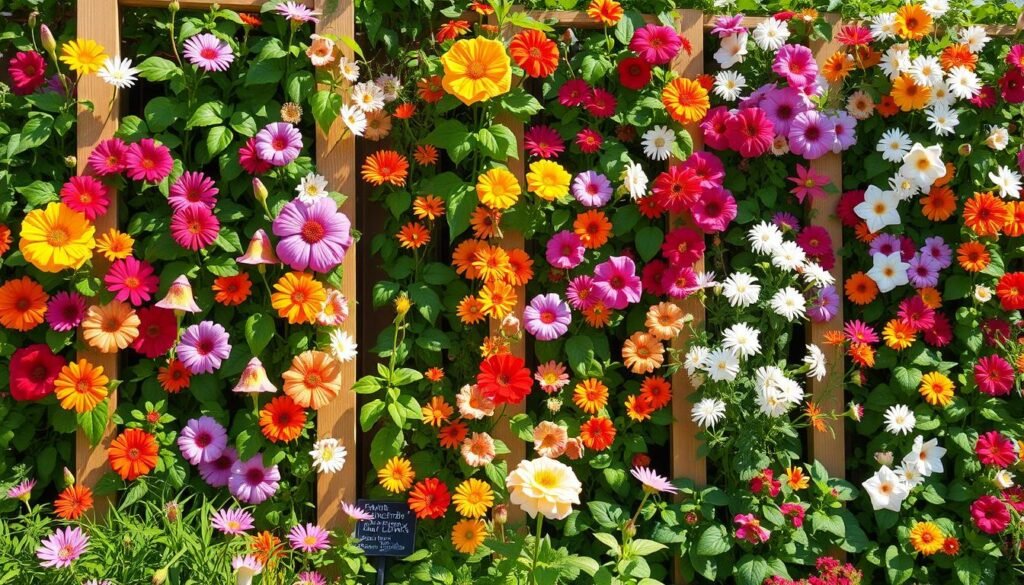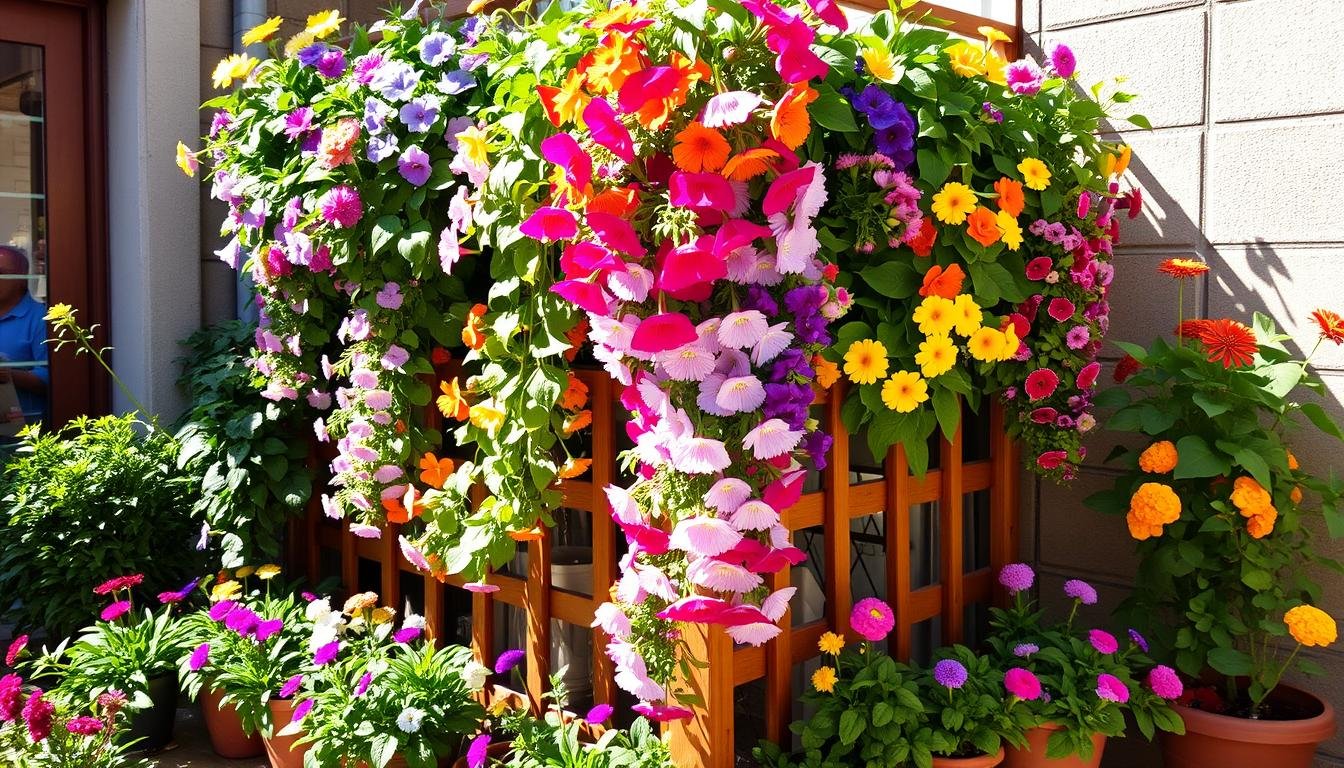Vertical gardening with flowers can transform small urban spaces beautifully. These methods not only look good but also boost privacy, cut down noise, and clean the air.
In busy cities, where space is rare, vertical gardens are a big help. They let you use space wisely by growing flowers up instead of out. This adds beauty and nature to your life, improving your mental health.
Starting a vertical garden helps you and the environment. It increases plant types and brings nature closer to you. Let’s turn those limited spaces into green, peaceful havens.

Benefits of Vertical Gardening in Small Spaces
Vertical gardening changes how we use small spaces for plants. It makes the most out of limited areas, letting you grow many plants without a big garden spot. It uses vertical structures to efficiently use space.

Vertical gardens are great for the environment. They need less ground soil and water, saving resources. They also allow city folks to grow their own plants and some foods.
Vertical gardens can cut energy costs by cooling areas and fight the urban heat effect. They make places cooler and more sustainable. Also, they’re great for people with physical challenges, making gardening accessible to all.
Using vertical gardening saves space and is good for the planet. It makes cities greener and healthier. Vertical gardens in your space are an effective and fulfilling way to enjoy nature in small living areas.
Choosing the Right Flowers for Vertical Gardens
When picking flowers for your vertical garden, the key is to know each plant. You need to check how much sun they need and how often they should be watered. Also, learn about how they grow. This makes sure they fit well with your garden’s environment. It’s vital to pick plants that do well in your local climate for a flourishing garden.

To pick the best flowers, look at plant hardiness zones. This helps you find out which ones will grow well in your area. Choosing plants that are native to your area usually means they grow stronger and are more sustainable. When you select flowers carefully, your vertical garden will not only save space. It will also be beautiful and full of life all year.
- Assess sunlight and watering needs when selecting flowers.
- Consider the growth habits of each plant.
- Consult plant hardiness zones for optimal choices.
- Choose native species for better adaptability and growth.
Vertical Pallet Garden Ideas
Pallet gardening is a unique way to make beautiful vertical gardens in small spaces. It uses old pallets to create areas where various plants can grow. This method is great for those looking to garden in an eco-friendly way.

Starting your own pallet garden is affordable and fun. Here are a few ideas to get your imagination going:
- Flower Paradise: Transform pallets into spaces filled with colorful flowers. Pallets help keep different flower types apart, making a lovely layered look.
- DIY Vertical Garden Structures: Turn pallets into upright structures that lean on walls or fences. Doing this uses less ground space and adds height to your garden.
- Edible Garden: Pallets are perfect for growing herbs and small veggies. Divide the pallet into sections for basil, mint, or lettuce.
Using pallets for gardening helps the planet and gives you a beautiful and handy garden space. A DIY pallet garden saves room and simplifies looking after your plants.
Setting Up a Vertical Raised Garden Bed
Creating vertical raised garden beds can change the way you garden, especially with little space. These beds are not just beautiful. They also make the most of your area by stacking plants up. This method lets you grow more in a smaller space and still looks great.

Vertical raised garden beds are great because they’re designed to be easy on your body. They’re perfect for people who find bending or kneeling hard. Having the garden bed higher means less pain for your back and knees. This makes gardening more enjoyable.
Setting up your garden bed is easy but very important. Making sure your garden is stable is key. You must anchor it well to keep it from falling over. This makes sure your garden can handle different weather and stay upright all season.
Here are some steps for setting up your vertical raised garden bed:
- Choose a Location: Look for a sunny place where your plants will grow well.
- Secure the Frame: Make sure the frame is solid and well-fixed to the ground or a wall.
- Soil Preparation: Pick top-quality soil that’s rich in nutrients for your plants.
- Plant Selection: Choose plants that grow well vertically, like vines or trailing flowers.
Using these tips will make your small-space garden work better and make gardening easier to get into. By adding easy-to-use garden designs and focusing on setting up right, you create a garden that’s both lasting and fun.
Vertical Landscaping with Flowers
Vertical landscaping with flowers uses living walls for creating beautiful and useful outdoor spaces. These living walls change plain surfaces into lively displays full of different flowers and textures.
Adding floral aesthetics to your vertical gardens makes them visually dynamic and changing. By selecting a variety of seasonal blooms, your garden will look different all year. This not only looks great but also helps local pollinators and increases biodiversity.
But vertical gardens aren’t just for show; they have practical advantages too. They can lower energy costs by insulating naturally, decrease surface temperatures, and purify the air. Living walls also reduce noise, making city life quieter.
Planning your vertical garden? Think about the plant weight and their roots. Pick the right mounts to keep plants healthy and walls safe. Make sure they get enough sun and water to thrive.
Choosing vertical gardens for your space is wise for both looks and the environment. With quality plants and regular care, your garden will remain vibrant. Adding flowers to your vertical spaces is pretty and ecologically beneficial.
DIY Vertical Garden Design Tips
Starting your DIY garden projects? First, think about how much weight your garden can hold. It’s important to pick plants that won’t be too heavy. This ensures your vertical garden planning doesn’t face any structural problems. For example, hefty succulents or some perennials might need stronger supports.
Don’t forget about water draining! If your garden doesn’t drain well, plants could get root rot. Make sure to have a good irrigation system or enough drainage holes. This keeps your plants healthy.
The soil you use is also key to your garden’s success. Choose a soil mix that’s light and drains well. Adding organic matter can make the soil better for plant growth.
It’s essential to keep your DIY garden projects safe and lasting. Build a sturdy frame with quality materials like treated wood, metal, or plastics. Checking it regularly helps avoid accidents and keeps your garden looking great.
Home gardening creativity lets you make beautiful and useful vertical gardens. You can use recycled stuff and arrange plants in special ways. Make sure the design fits your style and meets your plants’ needs.
Watering Techniques for Vertical Gardens
Vertical gardens need special care when it comes to watering. Drip irrigation systems are a top choice. They give water right to the roots, cutting down on evaporation. This way, every plant stays properly hydrated.
Adding self-watering systems to your vertical garden boosts its green credentials. These systems have reservoirs which slowly water the plants. This cuts back on the need to water by hand and keeps moisture steady.
For those keen on saving water, these methods are essential. Both drip irrigation and self-watering setups help conserve water and prevent too much water. Your plants will be healthier and your garden, greener.
Creative Vertical Garden Ideas for Urban Spaces
Vertical gardening is a cool way to add greenery to city life. Without much ground area, walls, balconies, and rooftops become green spaces. You can use recycled pallets, hanging shoe organizers, and old picture frames for unique gardens.
Adding art to your garden turns it into an eye-catching spot. Living walls can show off beautiful flower designs. At night, the right lights make them even more gorgeous. These artistic gardens make cities more beautiful. They also clean the air and cut down on noise.
Balconies and rooftops are great for vertical gardens. They can be calm places with lots of plants, trellises, and hanging vines. You can even grow herbs and veggies, having fresh food close by. Trying out these garden ideas can turn any urban space into a green retreat, away from the busy city
.






